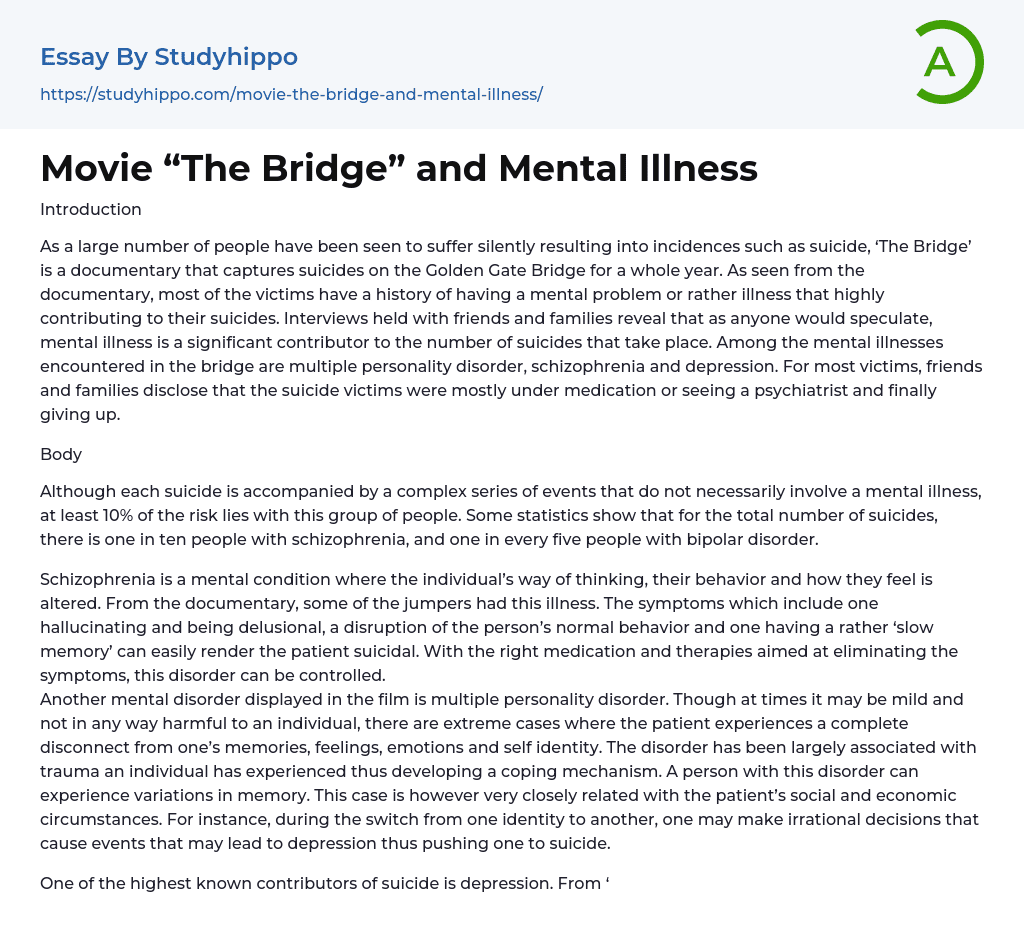Introduction
As a large number of people have been seen to suffer silently resulting into incidences such as suicide, ‘The Bridge’ is a documentary that captures suicides on the Golden Gate Bridge for a whole year. As seen from the documentary, most of the victims have a history of having a mental problem or rather illness that highly contributing to their suicides. Interviews held with friends and families reveal that as anyone would speculate, mental illness is a significant contributor to the number of suicides that take place. Among the mental illnesses encountered in the bridge are multiple personality disorder, schizophrenia and depression. For most victims, friends and families disclose that the suicide victims were mostly under medication or seeing a psychiatrist and finally giving up.
Body
Although each suicide is accompanied by a complex serie
...s of events that do not necessarily involve a mental illness, at least 10% of the risk lies with this group of people. Some statistics show that for the total number of suicides, there is one in ten people with schizophrenia, and one in every five people with bipolar disorder.
Schizophrenia is a mental condition where the individual’s way of thinking, their behavior and how they feel is altered. From the documentary, some of the jumpers had this illness. The symptoms which include one hallucinating and being delusional, a disruption of the person’s normal behavior and one having a rather ‘slow memory’ can easily render the patient suicidal. With the right medication and therapies aimed at eliminating the symptoms, this disorder can be controlled.
Another mental disorder displayed in the film is multiple personality disorder. Though at times it may be mild and not in
any way harmful to an individual, there are extreme cases where the patient experiences a complete disconnect from one’s memories, feelings, emotions and self identity. The disorder has been largely associated with trauma an individual has experienced thus developing a coping mechanism. A person with this disorder can experience variations in memory. This case is however very closely related with the patient’s social and economic circumstances. For instance, during the switch from one identity to another, one may make irrational decisions that cause events that may lead to depression thus pushing one to suicide.
One of the highest known contributors of suicide is depression. From ‘The Bridge’ as most families and friends explain, a large percent of the suicide victims had depression. Medically, persons diagnosed with this mental disorder have a high prevalence to committing suicide especially before they start responding to treatment. Patients may not all suffer from the same kind of depression as there are many types causing a variance in the severity. These include dysthymia, psychotic depression and perinatal depression among others. Accompanied by anxiety, a sense of hopelessness, restlessness, irritability and difficulties handling normal situations, depression clearly has symptoms that can easily make the victim resolve to committing suicide.
Conclusion
As discussed, majority of suicidal deaths captured in ‘The Bridge’ are associated with individuals who had one of these three mentioned mental disorders, although the list is not limiting. These conditions might be highly attributed to the medical field but proper medication is not the only way to reduce these suicides. Other measures may include better connection to the social life, showing a sense of care to the patients and providing a safe environment
to reduce suicide attempts. However, some of the people captured in the film survived the attempt while others were talked out of it and were seen to do well in the recovery process thereafter. For instance, there is a jumper who survived miraculously, who had been suffering from Schizophrenia. The jumper’s road to recovery is seen to be well progressive and thus the importance of not holding survivors in contempt, but helping them in their recovery.
References
- Living Is For Everyone (LIFE) – Research and Evidence in Suicide Prevention Commonwealth Department of Health and Ageing: Canberra. (2007).
- Adhd essays
- Antisocial Personality Disorder essays
- Anxiety essays
- Bipolar Disorder essays
- Depression essays
- Depression And Anxiety essays
- Dyslexia essays
- Learning Disability essays
- Major Depressive Disorder essays
- Mental Disorder essays
- Mental Illness essays
- Psychosis essays
- Schizophrenia essays
- Stress essays
- Suicide essays




